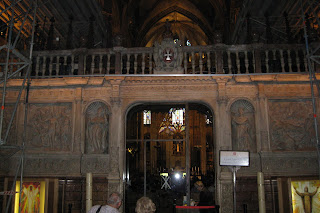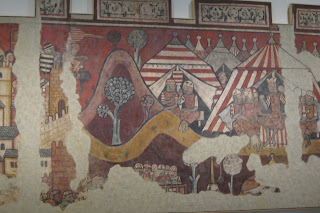

Friday, May 20 we arrived in Barcelona. The area where we docked is called the World Trade Center. Barcelona is the second busiest port for cruise ships, after Miami. To the left is the view from the ship. You can see a large old military headquarters building straight ahead. Behind it is a modern skyscraper. To the right is a statue of Columbus, supposedly pointing to the Americas, but in reality pointing in the wrong direction. Barcelona is the second largest city in Spain, after Madrid. The area has two official languages: Spanish and Catalan (similar to French). Entering the city from the ship meant going through airport-like security. We started the day with a bus tour of the city. Our guide pointed out the zoo. Next to it was the Parliament building. "The people like it. All the animals are in one place."

The first stop was the Sagrada Família Roman Catholic Church (shown in the picture at the top of this blog entry) designed by Catalan architect Antoni Gaudí (1852-1926). Some people consider Gaudí a genius; some crazy. Church construction started in 1883. Eight of the planned 18 towers have been built. The church will have three entrances. Inside the church it is remarkably bright. The openings in the towers let in a lot of sunlight. The view at the right is above the main altar. Decorations inside included images of religious scenes, fish, heads of local politicians, and so forth. Outside, more of the same. Even a 4 x 4 magic square where the rows, columns, and diagonals all add up to 33, the age of Jesus when he died. Gaudí was living in the unfinished church. In 1926 he was struck by a tram and due to his disheveled appearance and lack of identification was assumed to be a beggar. Because of lack of prompt medical treatment he died of his injuries.

We passed these bicycles. For €35 a year you can purchase a license that permits you to use one of these bicycles. You just have to pick it up and drop it off at one of the collection locations. Back in Seville there was a similar arrangement. There the guide told us the license was €10 per year for 30 minutes of free use. After 30 minutes it was €1 per hour, or you could just change bicycles.

Then we went on a walking tour along the narrow stone streets in the Roman part of the city. Members of our group are entering a palace located on the left. On the right is the chapel where it is believed that Queen Isabella and King Ferdinand gave Christopher Columbus the go-ahead for his explorations.

On the left is a view inside the palace.

We went to La Seu Cathedral. The cathedral (in the picture at the right) had numerous private chapels, a 16th century organ, and 13 live white geese in the cloister. The 13 live white geese are for a 13 year old girl, Santa Eulalia, martyred for her religion, but they also work well as "watchdogs."

We passed a building for lawyers. In the outside wall was this mailbox. Our guide said it indicated that: the law, like the mail, should be fast like the bird, but sometimes it is slow.
We were about to return to our ship for lunch. But our bus, manufactured by Volvo Avant Grup, could not move. There was a demonstration march by firemen in the street. Economic times are difficult; Barcelona's unemployment rate is 20%; and there were upcoming elections.
We had to keep track of our passenger identification card. When disembarking we took our yellow card with us. It was our identification in port. Our passports were held on the ship. The yellow card was sometimes checked by port security as we approached the ship to board. When embarking we returned the card to its location in the rack below, organized by cabin number. There was a crew member at the board making sure that we followed the procedures. To the left are the crew identification cards.


After lunch we went by bus to the site of the 1929 Barcelona International Exposition.
The Exposition was built on a mountaintop area that already had five palaces. The Spanish pavillion, shown at the left, has been converted into a museum, the Museu National d'Art de Catalyuna.

The museum contains a wide variety of art, from Roman frescoes, to these chairs by Antoni Gaudí, to early Pablo Picasso paintings. Gaudí designed many things besides the Sagrada Família Church. Here are chairs he designed, with arms for men, without arms for women, because at the time they wore wide skirts. Later Picasso paintings are in the Picasso Museum downtown.

After our visit we took a scenic drive with a panoramic view of Barcelona. We passed a cable car stop near the mountaintop. The other end of the cable car ride is down in the harbor area. We could see the cable car from our ship.
We returned to the Corinthian II to be welcomed with refreshment, this time apple juice with iced tea. At dinner one birthday and one anniversary were celebrated.